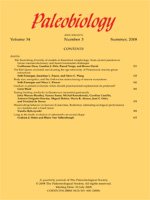Ecomorphological and biogeochemical (trace element, and carbon, nitrogen, and oxygen isotope ratios) analyses have been used for determining the dietary niches and habitat preferences of large mammals from lower Pleistocene deposits at Venta Micena (Guadix-Baza Basin, Spain). The combination of these two approaches takes advantage of the strengths and overcome the weakness of both approaches. The range of δ13Ccollagen values for ungulate species indicates that C3 plants were dominant in the diet of these mammals. δ13Ccollagen values vary among ungulates: perissodactyls have the lowest values and bovids the highest ones, with cervids showing intermediate values. The hypsodonty index measured in lower molar teeth and the relative length of the lower premolar tooth row indicate that the horse, Equus altidens, was a grazing species, whereas the rhino, Stephanorhinus etruscus, was a mixed feeder in open habitats. The similar δ13Ccollagen values shown in both perissodactyls does not reflect differences in feeding behavior with other ungulates, but rather a lower isotope enrichment factor in these monogastric herbivores than in ruminants, owing to their lower metabolic efficiency. The cervids Eucladoceros giulii and Dama sp. show low hypsodonty values, indicating that they were mixed feeders or browsers from forested habitats, an ecomorphologically based conclusion corroborated in the former by its low δ15Ncollagen content (canopy effect). Bovid species (Bovini aff. Leptobos, Soergelia minor, and Hemitragus albus) presumably inhabited open environments, according to their comparatively high hypsodonty and δ15Ncollagen values. Carnivore species (Homotherium latidens, Megantereon whitei, Pachycrocuta brevirostris, Canis falconeri, and Canis etruscus) exhibit higher δ15Ncollagen values than ungulates. These results record the isotopic enrichment expected with an increase in trophic level and are also supported by low bone Sr:Zn ratios. The elevated δ15Ncollagen value for a sample of Mammuthus meridionalis, which came from an individual with unfused epiphyses, confirms that it was a suckling animal. The δ15Ncollagen value of the scimitar-cat H. latidens is well above that obtained for the young individual of Mammuthus, which indicates that juvenile elephants were an important part of its diet. The hippo, Hippopotamus antiquus, yielded unexpectedly high δ15Ncollagen values, which suggest feeding on aquatic, non-N2-fixing plants. The high δ18Ohydroxyl values of bovids Hemitragus and Soergelia and of cervid Dama indicate that these ungulates obtained most of their water requirements from the vegetation. The megaherbivores and Eucladoceros exhibit the lowest δ18Ohydroxyl values, which suggest increased water dependence for them. Paleosynecological analysis was based on the relative abundance of species of large mammals from different ecological categories, determined by feeding behavior and locomotion types. The comparison of the frequencies of such categories in Venta
How to translate text using browser tools
1 June 2003
Paleoecological reconstruction of a lower Pleistocene large mammal community using biogeochemical (δ13C, δ15N, δ18O, Sr:Zn) and ecomorphological approaches
Paul Palmqvist,
Darren R. Gröcke,
Alfonso Arribas,
Richard A. Fariña
ACCESS THE FULL ARTICLE





